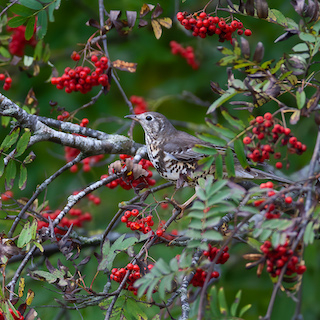 This Mistle Thrush found itself some tasty rowan berries near Gweek.
This Mistle Thrush found itself some tasty rowan berries near Gweek.
Photo: Richard Birchett
MISTLE THRUSH
Scientific name: Turdus viscivorus
Other common names: Stormcock, Bull Thrush, Holm Screech
Cornish name: mola is the general word for a thrush
Conservation status: IUCN Red List, Least Concern; UK Birds of Conservation Concern, Red
What to look for:
• Family: Chats and thrushes (Turdidae)
• Colouring and appearance: Pale cream to yellow colouration of the underparts, pale grey to brown upperparts, grey-white chin, black spots on throat and chest, black bill, yellow-brown feet. The wings are long (best seen in flight), and the tail is white-edged. The two sexes are very similar.
• Size: 27 cm length, 42 to 48 cm wingspan.
• Where: Throughout the UK all year, except at high altitudes and the north-westerly Scottish Isles. Seen in hedges, open woods, parks, and is a garden visitor.
• Call: Fluting and melodious song; rattling alarm call.
• Similar species: Song Thrush, which is smaller and less obviously spotted on its chest and underside.
 The Mistle Thrush is a bold-looking bird, with its upright, stocky bearing and curious gaze. The largest of the native European thrushes (and the largest British songbird), you can tell it from its cousin, the Song Thrush, by its bolder black spotted markings and larger size. The males have a fluting song, often sung from the tops of trees in winter to early summer to claim territory and attract a mate, but which is a little less varied, and perhaps less musical, than either the Song Thrush or Blackbird. They’ll often sing during and after rainy weather, earning the species the alternative common name of Stormcock.
The Mistle Thrush is a bold-looking bird, with its upright, stocky bearing and curious gaze. The largest of the native European thrushes (and the largest British songbird), you can tell it from its cousin, the Song Thrush, by its bolder black spotted markings and larger size. The males have a fluting song, often sung from the tops of trees in winter to early summer to claim territory and attract a mate, but which is a little less varied, and perhaps less musical, than either the Song Thrush or Blackbird. They’ll often sing during and after rainy weather, earning the species the alternative common name of Stormcock.
This is a pretty assertive species. Males are known to defend their breeding and feeding territory aggressively, even attacking birds of prey. Pairs are formed in the autumn. In the very early spring (February onwards), the cup-shaped untidy nests, built by the female (the male sometimes helps) from sticks, grass, moss and roots, are found aboveground, mainly in trees but also sometimes on ledges and cliffs. The female lays a clutch of three to five eggs. Generally, there are two broods per year, and the male feeds the first set of hatchlings while the female incubates the second clutch of eggs (sometimes using the same nest, while sometimes the second clutch is laid in a second nest).
The adults eat berries and fruit, as well as invertebrates such as slugs and snails. They particularly love mistletoe, which explains its name. In fact, the species name viscivorus means ‘devourer of mistletoe’.
Did you know…?
…Chaffinches and Mistle Thrushes often nest near each other. The former are vigilant in checking for intruders and sounding the alarm, while the latter are aggressive in defending their territory, so both species benefit from the arrangement.
More information and references:
Svensson, L., Mullarney, K., Zetterstrom, D.,1986. Collins Bird Guide, second edition (translated by Christie, D., Svensson, L.). HarperCollins, London.
Published: October 2020
Author: Amanda Scott
Photos: Richard Birchett (website and YouTube)
